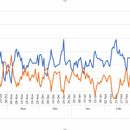Sizing a Heat Pump Based on Minimum Capacity
Hi everyone,
I’m replacing my gas furnace with a heat pump. I live in a 2000 sq ft detached house in a moderate climate (Vancouver, BC). I’ll be using the heat pump mainly for heating and maybe a few weeks a year for cooling.
I’m still waiting for an official energy audit report, but I’ve done a rough Manual J calculation myself and I have a heating load of ~22,500 BTU/h and a cooling load of 11,000 BTU/h.
I’m considering the following ducted units:
– Fujitsu AOU24RGLX/AMUG24LMAX, capacity range at 47F: 5,400-32,400 (https://ashp.neep.org/#!/product/33397)
– Mitsubishi PUZ-HA24NHA/PVA-A24AA7, capacity range at 47F: 11,500-27,000 (https://ashp.neep.org/#!/product/34518)
– Daikin DZ17VSA241A/DV24FECB14A, range: 5,700-22,800 (https://ashp.neep.org/#!/product/30721)
Pricing is more or less similar, while Daikin has a 12 years of warranty and the others have 10 years.
Heating season here is fairly moderate except for 3-4 days where it gets colder than usual (~18F.) Based on my estimates I normally need between 5,000-10,000 BTU/h and in those colder days I need 20,000 BTU/h (see attachment for a graph of outside temp in Celsius vs estimated daily kBTU/h average coming out from my gas furnace).
My question is finding the right balance between the max capacity and the min capacity. Mitsubishi is the only one among the three that has a max rating of 26k at 17F, Fujitsu has a max of 22.4k which is very close to the max heating needs. Daikin has a max of 17,300 at 17F which means I will need another source of heat in Winter. However, there are a lot of days where my load is not that high, and many days where the load is 10,000 or below. Fujitsu and Daikin have a much lower minimum capacity, which based on my understanding would perform better in the shoulder seasons.
Minimum cooling is 10,800, 11,500, and 7,500 for Fujitsu, Mitsubishi, and Daikin respectively, which is also very close to my cooling loads.
What’s the more reasonable choice here? Pick Mitsubishi so that I won’t have to worry about not having enough heating capacity if it gets colder one year? Would the 10,000 BTU/h min cause issues? Mitsubishi also seems to be the most efficiency one with a crazy COP of 5.33 at its min capacity at 47F, while Fujitsu is 2.88 and Daikin is 4.4.
Or pick Fujitsu/Daikin that can go much lower without cycling but might bottom out on those colder days?
GBA Detail Library
A collection of one thousand construction details organized by climate and house part










Replies
The Daikin looks good with its COP at warm temps: consider a small resistance heater in the air handler for the extreme weather. 3kw should suffice, make sure the installer keeps it locked out until it gets very cold or make it a manual switch. You may never use it, but it's cheap to add.
Thanks for the suggestion, I'll look into the back up heater option with Daikin a bit more.
Any idea how the COP and HSPF interact with each other? Daikin has a better COP in the warmer temps, but its overall HSPF (9.6) is lower than Fujitsu (10.7). Which number to trust more when it comes to predicting efficiency?
If you use NEEP, you'll find COPs are more specific than HSPF. Where HSPF is usually a warmer zone, near the Mason-Dixon line, specific COPs at given temps tell you how, for instance, your hardware will perform when YOU need it. NEEP also goes over colder New England termps and which hardware can even perform down near 5F, and if listed, -13F.
Ideally you’d have your heat loss at every outdoor temp and then you’d find the COP that corresponds to that capacity and temp. Then you’d weight that by hours spent at that temp. Its different for every house and climate so it’s not worth the effort. I usually just go with COP. How that daikin has a lower HSPF despite having higher COPs at what your load would be at 17 and 47 degrees is beyond me. HSPF is a noble effort, but it’s mostly useless.
As seen in this chart most of the time we are in between 38F-65F.
I don't quite get why the numbers are the way they are. I was expecting Fujitsu to be the most efficient at its minimum capacity, but it's not. Also find it odd that it's so much less efficient compared to the competition. However, based on the efficiency ratings (AHRI data) and anecdotal experience of people who have these units they should not be that inefficient - not sure what to make of it.